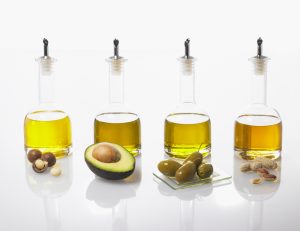
Fats are one of the three main macronutrients along with carbohydrates and protein. They are an essential part of a healthy eating plan.
However in recent times the role of fats and their health benefits have been the subject of debate. In fact in some instances the reputation of fats have been maligned.
Are fats bad for you? Are all fats equal in the health benefits they offer?
And if all fats are not equal, how do you know which fats to include, limit or avoid?
For answers to these questions, read on.
Role of fats in body?
Fats play a number of key roles, including being:
- A key source of energy
- A structural material for our DNA
- Essential for hormone production
- Vital for nervous system signaling
- Required for brain development
- Important to supporting vitamin absorption
- Essential for insulation, to keep you warm
- Important to skin and hair health
The Australian Dietary Guidelines recommend that fats should represent 20-35% of your total energy intake.
Why a bad reputation?
Research confirms fats have potential to play a contributory role in a number of health issues and diseases including obesity and heart disease. High level of fat intake has also been traditionally seen as a key contributor to raising blood cholesterol.
However, the role of fats and health issues or diseases is not black and white. Put simply not all fats are equal in their nutrient profile and hence their health benefits.
It means your choice of which fats to include in your daily diet, as well as the amount you include, will shape and influence the health outcomes you get from including fats.
What you need to know is there are fats to include, fats to limit and fats to avoid.
Fats to avoid: trans-fats
Trans-fats are created when unsaturated fats are solidified through a process called “hydrogenation”. This process is employed to increase the shelf life of foods, as well as allow for repeated reheating of oils during the manufacturing process.
You want to avoid trans-fats because they:
- Raise LDL (“bad” cholesterol)
- Lower HDL (“good” cholesterol)
- Increase cholesterol build up in arteries
- Increase inflammation
- Increase risk of stroke, heart attack, type 2 diabetes and other health complications
You generally find trans-fats in processed/refined/manufactured foods. Sources include:
- Supermarket baked goods
- Cookies and biscuits
- Take-away/fast foods
Fats to limit: saturated fat
Saturated fats are those that are solid at room temperature. Including small, limited amounts of saturated fats in your eating plan will help minimize potential health risks that arise when you include excessive amounts.
Excessive intake of saturated fat over time has potential to:
- Raise LDL (“bad” cholesterol)
- Increase cholesterol build up in arteries
- Increase risk of heart attack and stroke
Saturated fats can be found in foods and in processed food. Sources include:
- Dairy: butter, milk & ice-cream
- Fatty meats
- Coconut oil
- Palm oil
Fats to include: unsaturated fat
Unsaturated fats are typically liquid at room temperature. Unsaturated fats offer key health benefits. They have the potential to:
- Improve blood cholesterol
- Provide essential fatty acids (your body cannot make these)
- Lower risk of heart attack, stroke and diabetes type 2
There are two types of unsaturated fat:
Monounsaturated fats found in plant foods including:
- Olive oil
- Avocados
- Nuts and seeds (almonds, hazelnuts, pumpkin & sesame seeds)
Polyunsaturated fats, most commonly known as omega-3 and omega-6 essential fatty acids. They are found in plant and animal foods including:
- Sunflower oil
- Flaxseeds
- Walnuts
- Fish (salmon, mackerel, sardines)
How to include fats?
The key is to adopt some key principles:
- The ‘include/limit’ fats discussed above should make up 20-35% of your dietary intake
- Source the majority of your fats from unsaturated fats sources
- Keep intake of saturated fats limited, ensure you avoid excessive intake
- Where possible avoid trans-fats and
- Aim to include fats through eating foods that contain them (not from vitamin supplements).
Examples of foods rich in healthy fats are:
- First-pressed extra virgin olive oil
- Nuts, e.g. walnuts
- Seeds, e.g. pumpkin seeds
- Cold water oily fish (preferably wild), e.g. salmon, snapper, barramundi
- Avocados
I hope this has provided you with the fundamentals of what you need to know about including, limiting or avoiding fats.
If you would like to find out more about fats or other key nutrients or discuss healthy eating and building sustainable health and wellbeing, please click here to make contact .
ciao Jan
References
Harvard Health Publishing. (2017). The truth about fats: the good, the bad, and the in-between. Retrieved from https://www.health.harvard.edu/staying-healthy/the-truth-about-fats-bad-and-good
Eat for Health. (2015). Fat. Retrieved from https://www.eatforhealth.gov.au/food-essentials/fat-salt-sugars-and-alcohol/fat
